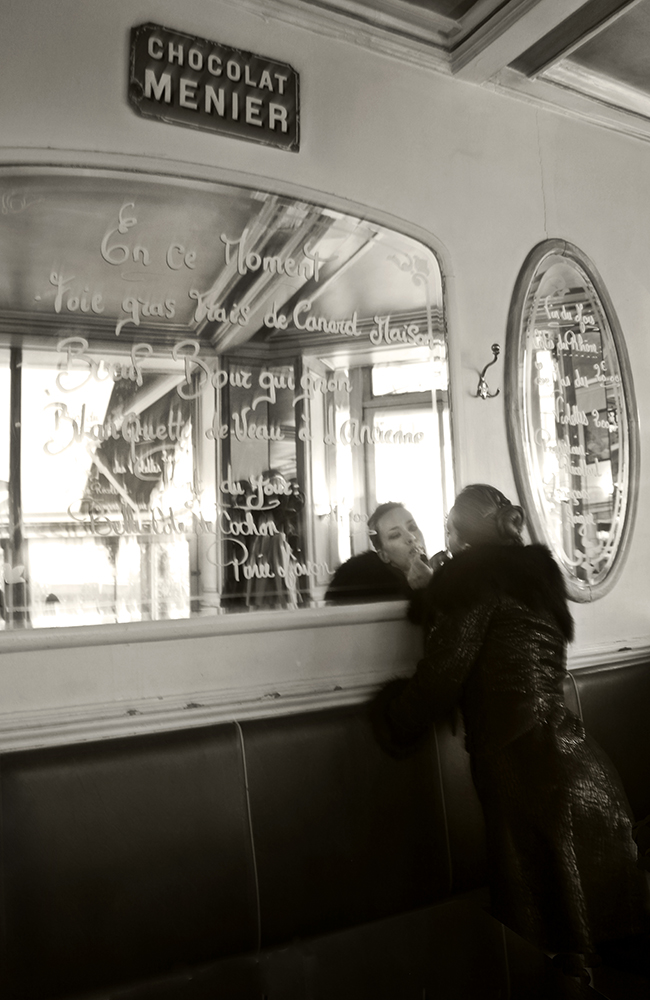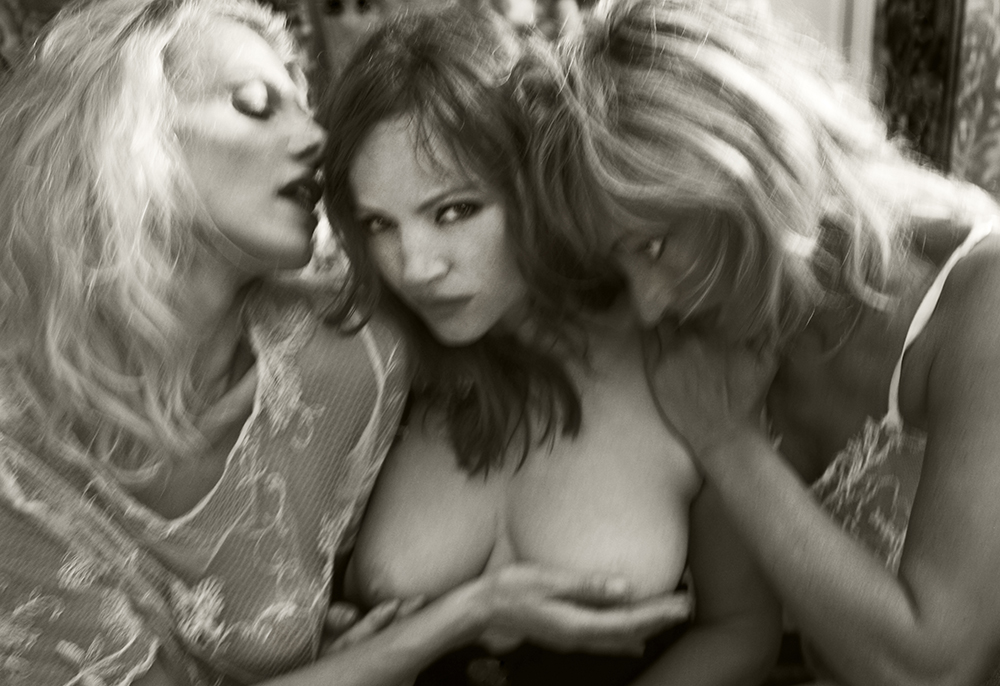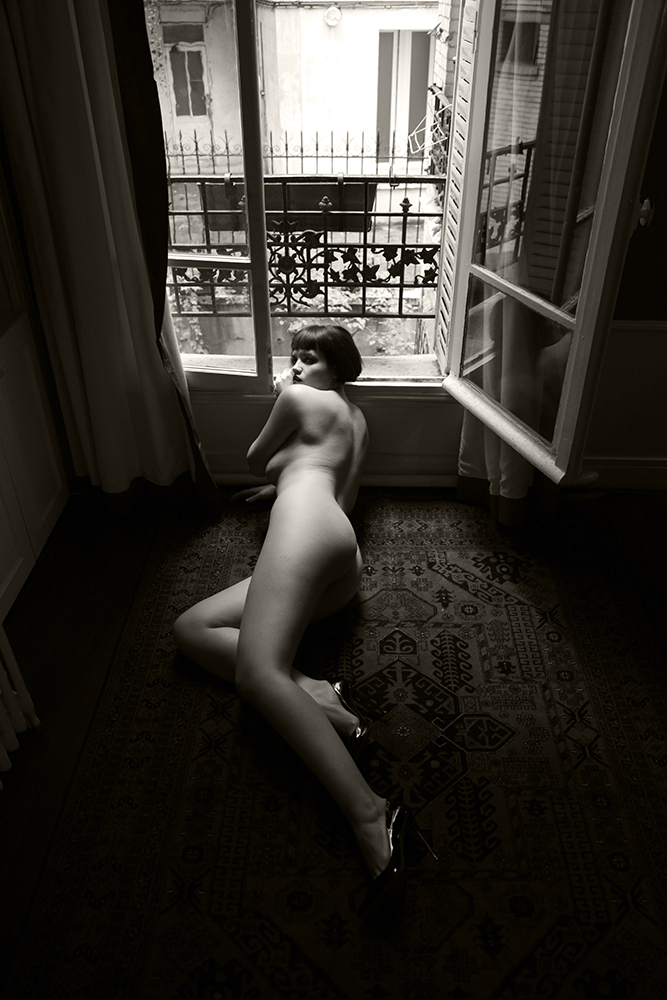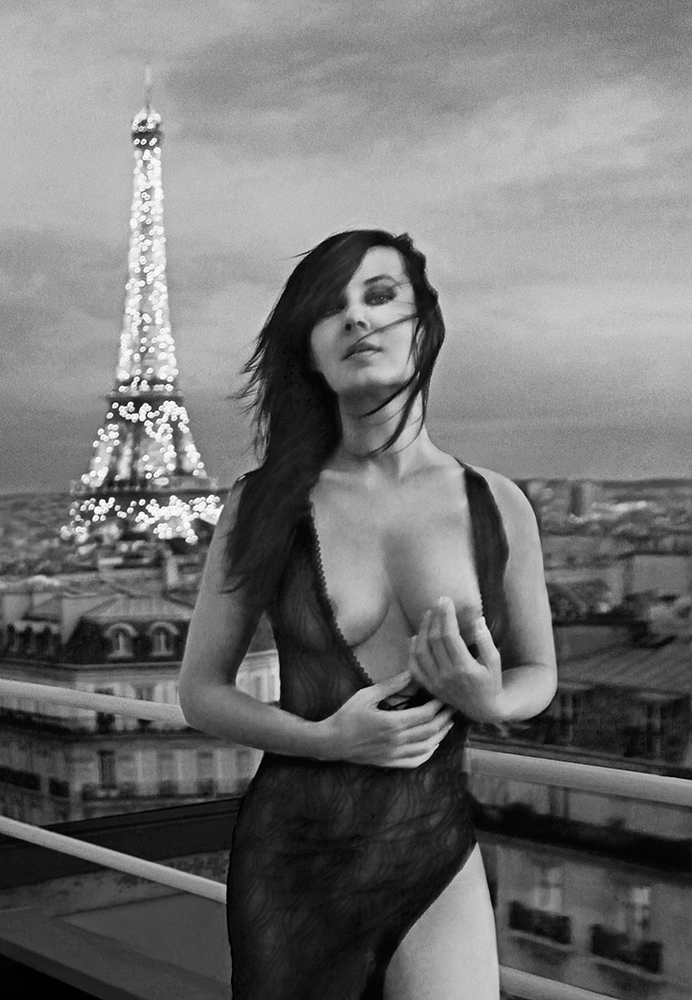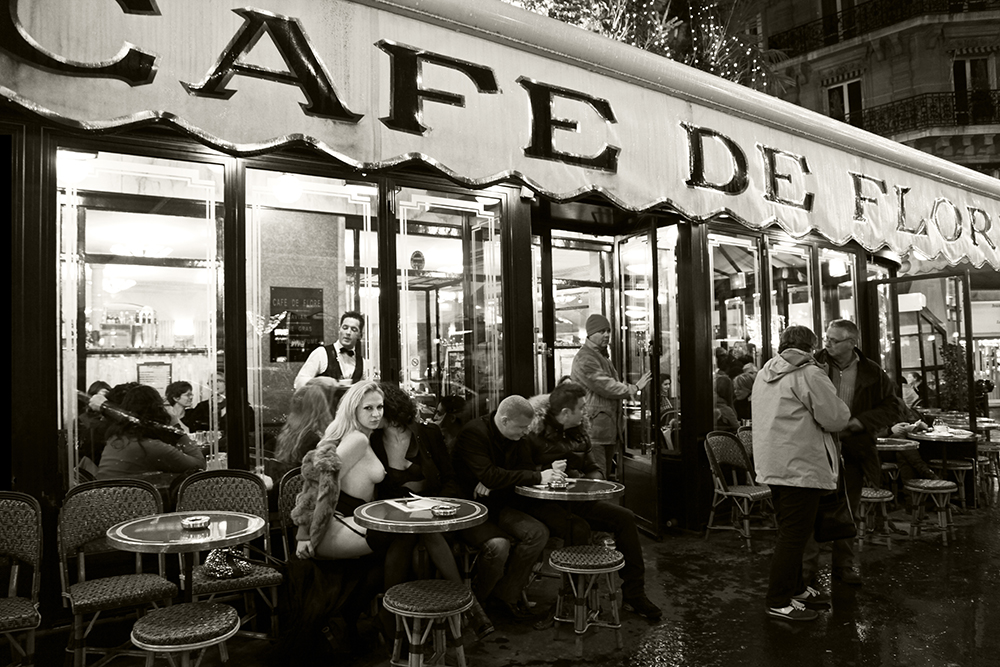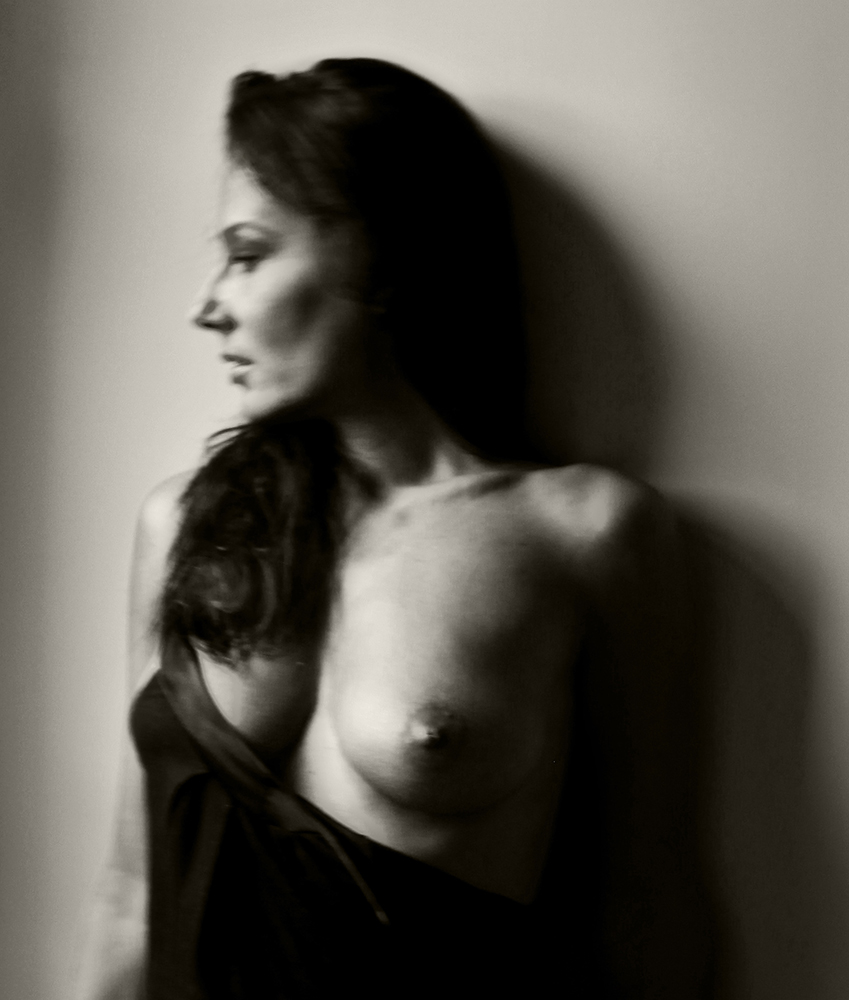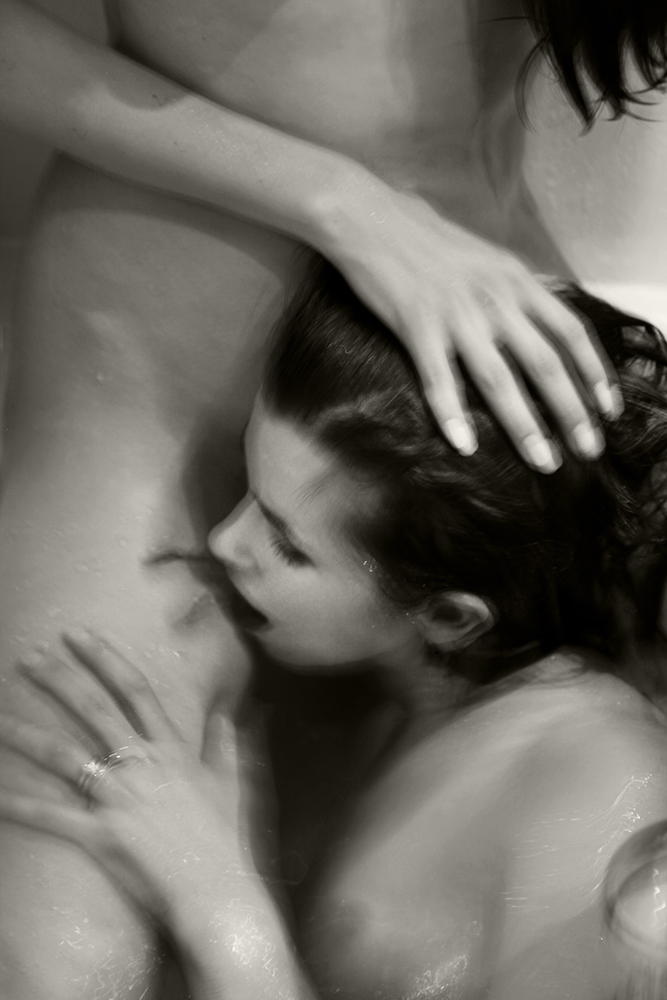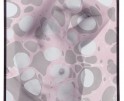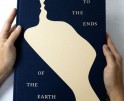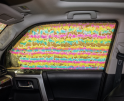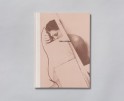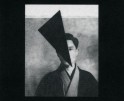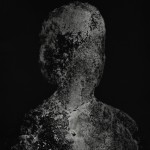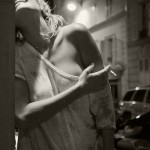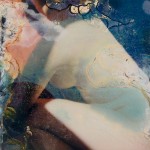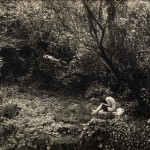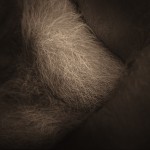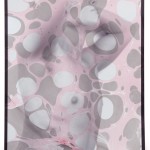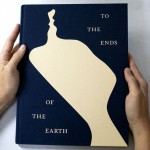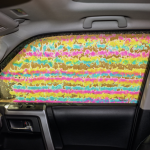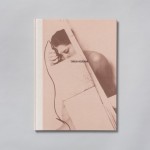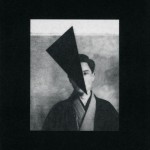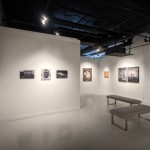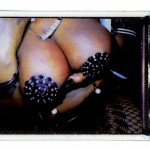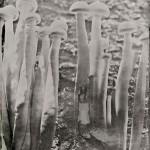Renée Jacobs: Polaroids and Paris
If you have ever thought about exploring your lustful and more libidinous fantasies about the feminine side of France and Paris, in particular, Renée Jacobs has an alternative for you. Her sensual and often provocative images of beautiful women expressing their sexuality are both honest and compelling. The images have a dark and somber tone that belies the wild and sexy provocations that she records. This is the Paris of fantasies with women posing alluringly and suggestively at the Café de Flore with sidelong glances toward the camera and an unposed waiter in the background engrossed in another conversation just behind them. There are the three Graces who cavort with one another while one Grace gives the camera a knowing glance of sheer devilishness. In another frame, an elegant beauty applies lipstick in a mirror that is actually a menu written in lipstick with foie gras as the first course…utterly ribald and delightful. One can tell that both the models and the photographer are toying with us and flaunting their femininity in a luscious confrontational manner.
Ms. Jacobs explores other exotic venues and situations with a new monograph, “POLAROIDS” and a second printing of an earlier monograph, “Paris”, that features the demi-monde of the City of Light in all its feminine and feminist glory. “POLAROIDS”, on the other hand delves int languorous scenes including that of a beautiful woman luxuriating in a bath with overtones of a Willy Ronis bather; another of a woman in profile staring out of the frame with her long hair dangling provocatively over an exposed breast; and another of a pair openly giving pleasure t one another. These are honest portrayals of women experiencing a cornucopia of erotic pleasures.
These two efforts by a lesbian/queer photographer are a paean to the liberating experience of expressing one’s sexuality openly and most importantly, providing a context for the desires she felt she lacked when she first came out. According to Ms. Jacobs, “whither art the lesbians in representing lesbian erotic desire? We have no Mapplethorpe. And gallerists go to extremes in desexualizing female nudes.” This is not an issue that she shies away from in her two monographs. Her models freely express their needs, their desires and their comfort with both just as the photographer does.
Ms. Jacobs says it best in her artist statements about these projects:
After beginning my career as a photojournalist in the 1980s, I dealt with my growing internal conflicts about recognizing my sexual orientation and about feeling “other-ed” by becoming a lawyer and bringing some of the earliest gay rights cases in the US.
When I returned to photography in about 2008 after practicing law for 15 years, one of my male “mentors” told me never to reveal my own sexual orientation or that of my models, for fear the “desire” of male gatekeepers and collectors would be impinged on. He also told me to “tone down” the sexuality and eroticism in my work.
It was then that I realized I needed to make these photos for me. I went from taking the more traditional headless bodyscapes of women to images that were more authentic. These are the photos that would have resonated deeply with me when I was coming out. These were the photos the models wanted me to make of them as they explored their own sexual spectrums. Artistically exploring the infinite and powerful landscape of women’s desires made me understand and accept my own.
For so long women have been told to hide their sexuality or pretend it doesn’t exist, or have it only exist to sell soap or shampoos but not to own the pride and power behind it. Sexuality is incredibly powerful. Lesbian sexuality in particular is either erased or exploited, but rarely empowered.
People often think a man made my images. I make no apologies for the eroticism of the women in my photos. We’re collaborating to make these images for us. I’m not interested in women as mere decorative objects. I’m not interested in allegory. I’m not interested in masking sexuality; I am interested in revealing it and reveling in all its diverse glory.
“POLAROIDS” represents some of my most erotic work to date. The use of the long-expired Polaroid Type 55 film and shooting with a Polaroid 110 camera converted for the 4”x5” film renders a positive that is always flawed, always imperfect—a medium perfectly suited to reflect desires that are not always on the surface, not always accessible, longings sometimes seen and felt only on the peripheries of our consciousness. Using this method for this body of work was a perfect way to engage my subjects in a more languorous, timeless type of reflection on female sexuality. The object of the book itself—a handstitched Japanese-style open spine—serves to enhance the elegance and individuality of the subject matter.
The new edition of PARIS contains some new images not in the original 2013 first edition. I originally went to Paris in 2011 as a rebound from a difficult time in my life. Like so many women, artists, outsiders—Paris ignited something liberating in me. I began to immerse myself in the writings and art of women who gravitated to Paris in the 1920s and 1930s seeking freedom and pleasure and quickly found a like-minded community of women of my own. I’m oft reminded of the Gordon Parks quote about Paris and how he used the City of Light as a fulcrum to move beyond discrimination he felt in the US:
“I needed Paris. It was a feast, a grand carnival of imagery, and immediately everything good there seemed to offer sublimation to those inner desires that had for so long been hampered by racism back in America. For the first time in my life I was relaxing from tension and pressure. My thoughts, continually rampaging against racial conditions, were suddenly becoming as peaceful as snowflakes. Slowly a curtain was dropping between me and those soiled years.
I was moving through centuries of history, and not unaware of the possibility of its help in shaping my future. Being a part of it was like feeling at once young and old.”
Renée Jacobs is a celebrated photographer of the female nude. Recipient of the prestigious International Photography Award for Fine Art Nude, her work has been exhibited and published around the world. Her next major exhibition is alongside Helmut Newton’s “Private Property” at Fotonostrum Gallery in Barcelona in May 2022. An American, she now lives with her wife in southwest France.
Renée learned analog photography in high school where she grew up outside of Philadelphia, PA and continued at Penn State University where she studied photojournalism in the early 1980s. Her early photojournalism included assignments for The New York Times, Philadelphia Inquirer and many other newspapers and magazines. She received the Robert F. Kennedy Award for Outstanding Coverage of the Disadvantaged and her work is in the permanent collection of the John F. Kennedy Presidential Library.
Her first book, “Slow Burn: A Photodocument of Centralia”, Pennsylvania was originally published in 1986 and re-issued in 2010 to favorable reviews in The New York Times Review of Books and photo-eye. The archive for Slow Burn now resides at Duke University. After a 15 year detour as a Constitutional and civil rights litigator (during which time she filed some of the earliest gay rights cases in the US in 1990), Renée returned to photography, focusing on the female nude.
Monographs of her work include Werkdruck (2012/Editions Galerie Vevais, edited and with an introduction by Jock Sturges); Renée Jacobs’ PARIS (2013/Editions Galerie Vevais) and Rêves de Femmes (2014/Editions Bessard, selected by photo-eye as one of the “Books of the Year.”)
In addition to her own monographs, numerous anthologies by publishers such as Taschen and magazines such as Snoecks, Vanity Fair France, Elle Italia, Silvershotz, Fotonostrum, Adore Noir, PH Magazine, Fine Art Photo, Nude Magazine, Photoicon, French Photo, B&W Magazine, Focus, Playboy Italy, FHM Turkey and many others have featured Renée’s work. She has exhibited in France, Italy, the US, Thailand, Japan, Belgium, South Korea and numerous other countries.
Follow Renée on instagram @reneejacobsphoto
Check out her B&B and workshops!
You will soon have an exhibition in Barcelona in close proximity to another exhibition by Helmut Newton. This raises an interesting question regarding what distinguishes your work from the work of a male photographer photographing fine art nudes?
The same thing that distinguishes any photographer from any other photographer. The level of emotional investment and clarity in the work. Every photographer-photographing the female nude or any other subject—brings their life experience, hopes, dreams, passions to their work. Newton was responsible in large part and for a long time in creating the way the photo world pictured women together. I have a different perspective of lived experience to bring to that discussion and I think it’s going to be a wonderful exhibit. I’m honored and excited to expand the dialogue alongside Newton’s work. I think the comparisons and contrasts vis a vis the presentation of “lesbian” imagery will be particularly fascinating.
I’m often asked if men can take good photos of women, particularly nudes. Absolutely. My favorite photograph of a woman is by a man. Edouard Boubat’s “Lella.” After that image, I don’t know why any of us try to photograph women qua women. It has everything—longing, beauty, intelligence, mystery, gorgeous light and composition.
Who are your photographic influences in the world of fine art photography?
All the classics, especially the French photographers or photographers that were very active in France. Boubat I mentioned. Lartigue I absolutely love. Kertesz, Brassai, Cartier-Bresson. I started as a photojournalist, so from that genre, W. Eugene Smith, Mary Ellen Mark, Eugene Richards.
There have been several legendary women fine art photographers who have photographed female nudes including Ruth Bernhard, Imogen Cunningham and Diane Arbus, to name a few. What makes your work unique from an historical perspective?
To my knowledge (and I’d be happy to learn if I’m wrong), women have shied away from even the whiff of eroticism in their work. Bernhard identified as a lesbian for much of her life but I think was quoted in an interview as saying she hoped that never colored her work-that she didn’t want to photograph or present anything reflecting her attractions. I feel exactly the opposite. I want my passions and those of the women I photograph to come through with as much authenticity and representation as is possible. There is a trend nowadays to show women photographers of the nude with bromides and disclaimers that the work is absent the “sexualization” of male photographers. Why is that the goal? More headless, faceless women? Another false and anodyne binary that doesn’t help anyone.
Your work has a moody and somber aura that seems to contradict the somewhat hedonistic subject matter portrayed? Why have you made this choice?
That’s an absolutely fascinating question and no one has ever asked it. On some level, I’ve sort of subconsciously been waiting for it. In the introduction to my PARIS book, Professor John Wood comments on a certain joy in the work, but I absolutely think it’s balanced by unrequited longing. My photography reflects so much of my sense of loss about being repressed for many, many, many closeted years. In that regard, I think of my work as a type of visual activism that is a direct through-line from my time as a civil rights litigator bringing some of the earliest gay rights cases in the US, while still deeply in the closet. But it’s true—to me, in my work and other photographers—the thing I find most compelling is longing and how it’s expressed.
As a lesbian/queer photographer presenting your view of female-on-female intimacy, how do you deal with the possibility that you may be ironically objectifying women from your own perspective?
It’s about time women were allowed to objectify ourselves and one another. I suppose that’s somewhat glib and obviously deals with a superficial, glancing definition of “objectify.” But the bottom line is that if we don’t define ourselves and our desires, someone else will. We’ve been there, done that. We didn’t get so much as a t-shirt. The most important thing to me is that the women in the photographs feel like their desires are being represented authentically. It’s not my job nor that of the viewer to judge those desires. So many of my photographs start from a conversation along the lines of, “I’ve always wanted to…….” and then we go from there. That’s about as far from objectification as it gets. It’s more of an elevation. It’s representation. It’s listening. It’s agency. It’s authenticity. I would posit that images that disassociate the faces and gazes of women in nudes and reduce us simply to bodyscapes are much more objectifying. I’m in awe of the power of these women.
I recently saw a quote something along the lines of “By not using our voices while telling stories about us you leave us out of our own narrative and you confirm our status as less important with no voice. We deserve to tell our own story.” Also, to me the biggest issue with my type of work (or really any photography) is consent. If the most erotic explicit imagery is done with joy and consent, it’s a lot less objectifying than, say, Winogrand stealing images of women on the street without their consent. There’s an absolutely fabulous article I always point to about this– http://jmcolberg.com/weblog/extended/archives/the_ethics_of_street_photography/
Since you now have two thematically similar books in hand, what new projects do you have on the horizon?
POLAROIDS will also be coming out in a few months as a special limited edition of 30 each with an original new Polaroid taken within the last year or so specifically for this project. I have a huge body of work that would form the basis of an ITALY book as a follow up to PARIS if I can just get back to that magnificent country and do a little more shooting. We’re immersed in our new, strange wonderful life in France so we’re making the most of our idyllic little spot for workshops and a b&b. And I have a super-secret project that maybe 3 people have seen—probably the most erotic work I’ve done to date. I have to think about the best way to bring that forward. The images are complicated and while I’d love to have them in a book, how to format it would be very tricky. They’d best be seen really large on walls but I haven’t done any groundwork on that yet.
Posts on Lenscratch may not be reproduced without the permission of the Lenscratch staff and the photographer.
Recommended
-
Christa Blackwood: My History of MenJuly 6th, 2025
-
Jeanette Spicer: To the Ends of the EarthJanuary 21st, 2025
-
Smith Galtney in Conversation with Douglas BreaultDecember 3rd, 2024
-
Tarrah Krajnak: Master Rituals II: Weston’s NudesMay 30th, 2024
-
European Week: Sayuri IchidaMarch 8th, 2024


